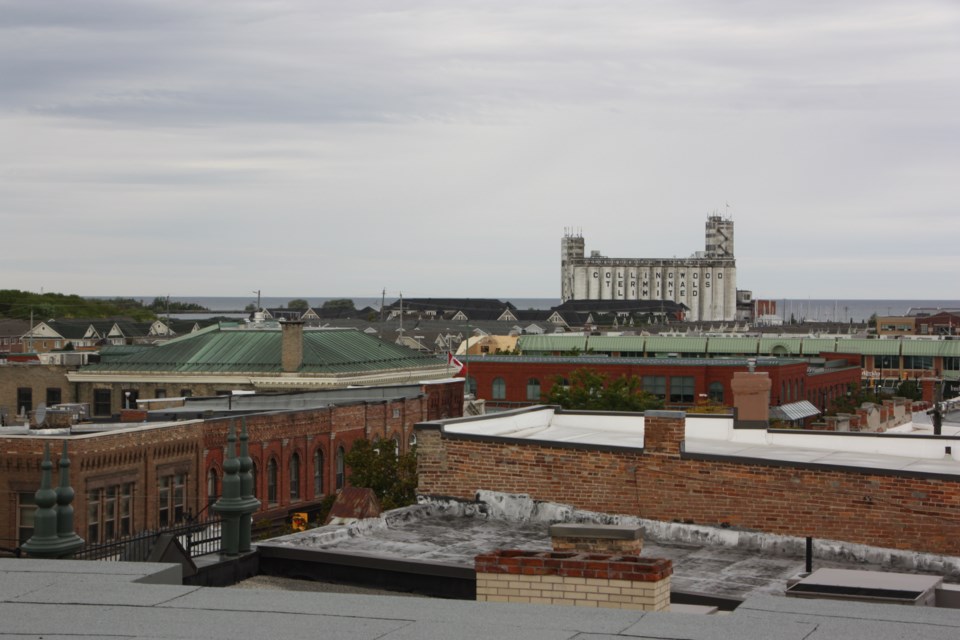Council could be making a decision on the future of the terminals as early as spring of 2020, and in the meantime, they’re diving deeper into the state of the 90-year-old building.
At a strategic initiatives committee meeting today at the Collingwood Legion, councillors voted unanimously in support of two actions.
First, to spend $10,000 to have a diver or drone inspect the 4,000 wood piles underwater that make up the foundation of the building. While an engineer report last year indicated the terminal building was sound, it included a caveat stating the piles had not been inspected.
The Collingwood grain elevator and silos building was constructed in 1929 over nine months and includes a wood pile foundation, a concrete raft slab and 52 concrete silos rising approximately 100 feet above the base.
The building operated until 1993 and the Town of Collingwood purchased the site in 1997.
At today’s meeting, the committee also voted unanimously in favour of undertaking a public consultation process on the future of the terminals, and, in particular, a white paper prepared by staff on the status of the building and future possibilities.
The meeting took place at the Legion to accommodate added public attendance. During the discussion, several members of the audience came forward with questions on the terminals.
In particular, they raised concern over the rent collected from telecommunication uses on top of the terminal building ($30,000 a year) and rental from the Collingwood Yacht Club of the property at the base of the terminals ($15,000 a year).
Another resident asked how the report came up with a $2 million cost for removing an estimated two-feet of bird guano from one of the towers.
Director of Engineering and Public Works Brian MacDonald said the estimate came from the previous consultant’s report.
“It’s a big project,” said MacDonald. “It’s very complicated in how you’d have to access the material.”
He added the tower is 10 storeys high, but there are no floors in the tower. As well, there are more hazardous materials including asbestos tiling throughout the building. The $2 million estimated for clean up includes cleaning up all hazardous materials and would have to be completed whether the building was demolished or preserved.
Regarding the yacht club rental rates, Director of Parks, Recreation, and Culture Dean Collver said the agreement was made decades ago and without cancellation clauses.
“Unfortunately all of the renewal components of the document were non-negotiable,” said Collver, adding the rate was established based on market rates compared to other municipalities and similar relationships.
Based on a presentation by Sonya Skinner, the town’s executive director of customer and corporate services, the town will move forward with a news release and public engagement through the town’s Engage Collingwood site, and interactive public town hall engagement sessions.
The town will also meet with interested commercial and community parties upon request, and come back to the Strategic Initiatives Committee early in 2020 with more information to help council make a decision on the future of the terminals.
No meeting dates have been announced yet.
The draft white paper includes a list of seven potential “physical ends” for the terminals' structure ranging from preservation of the exterior to renovation to include commercial space, to demolition.
The potential options include:
- preserve the exterior, hold at a safe state
- preserve the exterior and renovate commercial space in the east building, for example into a brew pub
- the second option plus top floor commercial space
- preserve part of the exterior (one or more silos) and include park, historical exhibits
- preserve and re-use essentially all of the structure, which is considered only viable in private or public/private ownership
- demolish and leave as green space, with intent to create outdoor space celebrating history of the site and harbour
- demolish and rebuild something new through a private or public/private partnership
However, the options to renovate the building are contingent on other sources of funding, including private/public partnerships, according to the white paper.
“In the absence of this process determining other funded physical end states and uses, it is assumed that [demolition] will be the path remaining open to council,” states the draft white paper.
To read the draft white paper and staff report, click here.
